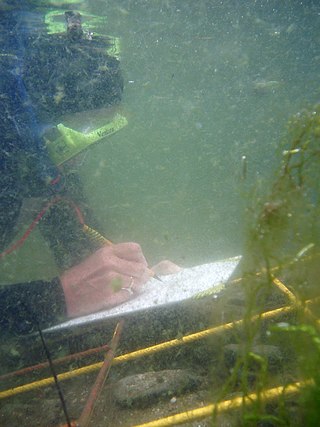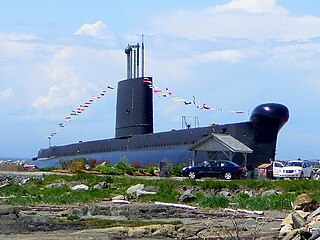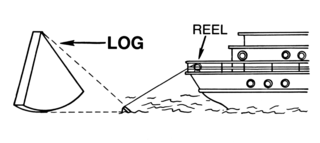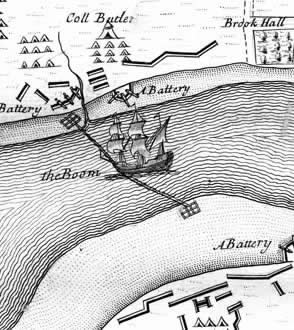Related Research Articles

A boat is a watercraft of a large range of types and sizes, but generally smaller than a ship, which is distinguished by its larger size or capacity, its shape, or its ability to carry boats.

A submarine is a watercraft capable of independent operation underwater. The term “submarine” is also sometimes used historically or informally to refer to remotely operated vehicles and robots, or to medium-sized or smaller vessels. Submarines are referred to as boats rather than ships regardless of their size.

Sonar is a technique that uses sound propagation to navigate, measure distances (ranging), communicate with or detect objects on or under the surface of the water, such as other vessels.

Underwater archaeology is archaeology practiced underwater. As with all other branches of archaeology, it evolved from its roots in pre-history and in the classical era to include sites from the historical and industrial eras.

HMCS Onondaga (S73) is an Oberon-class submarine that served in the Royal Canadian Navy and later the Canadian Forces. Built in the mid-1960s, Onondaga operated primarily with the Maritime Forces Atlantic until her decommissioning in 2000 as the last Canadian Oberon.

A chip log, also called common log, ship log, or just log, is a navigation tool mariners use to estimate the speed of a vessel through water. The word knot, to mean nautical mile per hour, derives from this measurement method.

The Gotland-class submarines of the Swedish Navy are modern diesel-electric submarines, which were designed and built by the Kockums shipyard in Sweden. They are the first submarines in the world to feature a Stirling engine air-independent propulsion (AIP) system, which extends their underwater endurance from a few days to weeks. This capability had previously only been available with nuclear-powered submarines.

The United States Navy Memorial is a memorial in Washington, D.C. honoring those who have served or are currently serving in the Navy, Marine Corps, Coast Guard, and the Merchant Marine.

The British U-class submarines were a class of 49 small submarines built just before and during the Second World War. The class is sometimes known as the Undine class, after the first submarine built. A further development was the British V-class submarine of 1942.

Pitometer logs are devices used to measure a ship's speed relative to the water. They are used on both surface ships and submarines. Data from the pitometer log is usually fed directly into the ship's navigation system.

Outlander is a 2008 action film written and directed by Howard McCain, starring Jim Caviezel, Sophia Myles, Jack Huston, John Hurt, and Ron Perlman. The plot is loosely based on the Anglo-Saxon epic poem Beowulf, adapted to a science fiction backstory involving a spaceship crashing in Iron Age Norway. The film grossed US$7 million compared to a budget estimated at $47 million.

HMS P38 was a Royal Navy U-class submarine built by Vickers-Armstrong at Barrow-in-Furness.
An Electromagnetic Log, sometimes called an "EM log", is an electronic sensor which measures the speed of a vessel through sea water. Like many other technologies, its name derives from the traditional chip log. It makes use of Faraday's law of induction by measuring the EMF induced in water moving through a magnetic field generated by the sensor.

The McCann Submarine Rescue Chamber is a device for rescuing submariners from a submarine that is unable to surface.

The Torpedo Data Computer (TDC) was an early electromechanical analog computer used for torpedo fire-control on American submarines during World War II. Britain, Germany, and Japan also developed automated torpedo fire control equipment, but none were as advanced as the US Navy's TDC(?), as it was able to automatically track the target rather than simply offering an instantaneous firing solution. This unique capability of the TDC set the standard for submarine torpedo fire control during World War II.

A boom or a chain is an obstacle strung across a navigable stretch of water to control or block navigation.

The Anti-Submarine Warfare Shallow Water Craft (ASW-SWC) corvettes, are a class of anti-submarine warfare (ASW) vessels currently being built for the Indian Navy, by Cochin Shipyard (CSL) and Garden Reach Shipbuilders & Engineers (GRSE). They were conceived as a replacement to the ageing Abhay-class corvettes of the Indian Navy, and are designed to undertake ASW duties – including subsurface surveillance in littoral waters, search-and-attack unit (SAU) missions and coordinated anti-submarine warfare operations with naval aircraft. They were also designed to provide secondary duties – including defense against intruding aircraft, minelaying and search-and-rescue (SAR).

Recreational dive sites are specific places that recreational scuba divers go to enjoy the underwater environment or for training purposes. They include technical diving sites beyond the range generally accepted for recreational diving. In this context all diving done for recreational purposes is included. Professional diving tends to be done where the job is, and with the exception of diver training and leading groups of recreational divers, does not generally occur at specific sites chosen for their easy access, pleasant conditions or interesting features.

United States Navy submarines, surface ships, and aircraft launch torpedoes, missiles, and autonomous undersea vehicles as part of training exercises. Typically, these training munitions have no warhead and are recovered from the sea and reused. Similarly, new naval weapons under development are launched at sea in performance trials. These experimental units also need to be recovered, in their case to obtain evaluation data. At various points in history, newly manufactured torpedoes were fired as a quality control measure and these, too, had to be recovered before issuing them to the fleet. The U.S. Navy has used a variety of boats to accomplish the retrieval of these test and training munitions. As their missions evolved over the last century they have been variously known as torpedo retrievers, torpedo weapon retrievers, torpedo recovery boats, range support craft, and multi-purpose craft.

Submarine rescue is the process of locating a sunk submarine with survivors on board, and bringing the survivors to safety. This may be done by recovering the vessel to the surface first, or by transferring the trapped personnel to a rescue bell or deep-submergence rescue vehicle to bring them to the surface. Submarine rescue may be done at pressures between ambient at depth, and sea level atmospheric pressure, depending on the condition of the distressed vessel and the equipment used for the rescue. Self-rescue of submarine personnel by buoyant free ascent at ambient pressure is considered submarine escape. Survivors may require recompression treatment for decompression illness.
References
- ↑ "Underwater Log Systems". USS Bowfin Submarine Museum & Park. 2002. Archived from the original on 2006-08-25. Retrieved 2006-08-26.